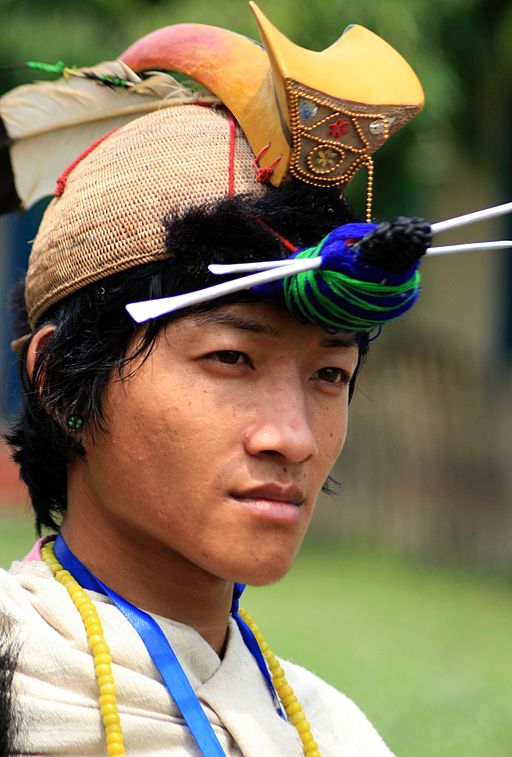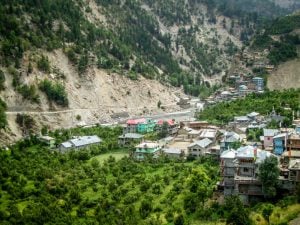In the lush forests bordering the Pakke Tiger Reserve in Arunachal Pradesh, a new conservation movement is in motion to save the fast disappearing hornbills of northeast India. The tribes – who once hunted the exotic birds in large numbers – are now protecting their nests to help their numbers rebound.
The Great Hornbill is a beautiful bird, easily recognisable by its enormous, bright yellow beak. Hornbills get their name from the horn like projection on top of their beaks, called a casque. A scheduled species under the 1972 Wildlife Protection Act, hornbills are hunted for their beaks, which are used to make the traditional headgear of the Nyishi tribe men. Hornbills are also hunted for their oil—believed to relieve pain — and for their meat.
By the end of the twentieth century overhunting had pushed the Great Hornbill – ironically the state bird of Arunachal Pradesh – onto the IUCN’s protected species list.
For the Nyishi community today, however, such practices have long faded. Today, they pride themselves on being the hornbills’ “nest protectors”.

Hornbill conservation
Budhiram Tai is one of the 16 hornbill nest protectors of the Nyishi tribe who has been trained by the NGO, Nature Conservation Foundation (NCF), to monitor the birds’ activities and keep a close watch on their nests. He marks trees that contain nests so that no one cuts them—either for timber or to clear space for agriculture. This is important since habitat loss is another major threat to the hornbill population.
These nest protectors also document interesting bird activities they come across. Budhiram for example, said he was watching the female hornbill enter a tree cavity—hornbills use cavities that have been pecked by a woodpecker or created by tree decay as their nests — when he observed unusual behaviour from the male bird.
“Hornbills usually use their own droppings to seal the cavity from the inside once the female enters for breeding. But we observed the male hornbill bringing clods of mud to seal the hole,” Budhiram said. According to Aparajita Dutta, scientist at NCF, this was the first time such behaviour was observed.
The hornbill chick emerged feom this nest three months later in the first week of July. This is one of forty-one hornbill nests under the NCF’s radar in east Kameng in Arunachal Pradesh; 18 were active this year.
Adopt a hornbill
Protecting the nests, however, is not the only facet of this conservation programme. It also invites outsiders to “adopt” a hornbill’s nest for INR 6,000 (USD 88), which pays the salary of nest protectors and other costs of the programme, including support for the community. About 100 people have adopted nests and continue their support every year.
In 2011 NCF, who have been studying the birds and monitoring its nests in the Pakke Tiger Reserve since 2003, decided they needed to extend their work outside the protected area, where there has been an increase in direct competition among hornbills for nests because of habitat loss.
“Until 2011 our monitoring efforts were restricted to 30-40 nests each year inside the protected area due to limitation of staff and funding. Now we have expanded to the area outside the Pakke Tiger Reserve. We started with three nest protectors from three villages and have now 16 protectors from 13 villages,” an NCF official said.
In 2013, 26 nests were found in the Papum Reserve Forest, of which 12 were active and 11 were successful, resulting in a nesting success rate of 91%. In 2016, 18 of the 41 nests monitored were active.
Since it started in 2011, the programme—in association with the Arunachal Pradesh forest department and the Ghora-Aabhe Society, an NGO formed by the Nyishi members for this very purpose — has seen support from both individuals across India and abroad, as well as from schools and zoos. The Greater Vancouver Zoo is one of the major supporters; the Attice Zoo in Athens, Amiens Zoo Metropole in France and Atlanta Zoo in US have also adopted some nests.
Tana Tapi, divisional forest officer at the Pakke Tiger Reserve, said, “This model of co-parenting is very successful in protecting the hornbills. The community which knows the bird and its habitat so well, now knows that the law does not allow them to kill the bird. But they are not just being asked not to kill it; they are offered incentives (a salary of INR 5,000-6,000 [USD 73-88] per month) to protect it.”
The hornbill population has grown by about 20-25% since the nest adoption programme came into being, according Tapi, although there is no official census of the bird population.
Winning hearts and minds
Changing mindsets and entrusting the local community with the responsibility of protecting the birds was not easy.
Debobroto Sarkar of the Wildlife Trust of India (WTI) — which has worked with the Nyishi community for more than a decade now—said that it took them intensive efforts to finally break the ice.
“We began our work back in 2000-2002 when we started studying the significance of the Greater Hornbill to the Nyishi community’s culture. The bird’s beak on the cane cap signified valour, manhood; it was revered. Although it was a Nyishi culture, other local men also wore the headgear; hence the bird was hunted in large numbers,” Debobroto said.
Artificial hornbill beaks
WTI therefore began with awareness campaigns on the significance of the bird to the forest ecosystem, how these “farmers of the forest” disperse seeds, and how the law forbids them from killing it. From there they went on to offer an alternative to the beak-cap.
“We offered the community an alternative of a fibre glass replica which was more long lasting than the original. The community offered modifications, and it was finally accepted. We provided 5,000 caps initially,” Debobroto said, adding that local self-help groups were then trained to make these caps to sell them commercially.
Conservation efforts have also encouraged eco-tourism in the state, said Tana Tapi. “Apart from adopting a nest, people from urban areas are now curious to see the hornbill’s nest.” Nest protectors are also helping to clamp down on poachers by reporting suspicious activities to authorities, he added, to up the ante in the fight to save the hornbills.








